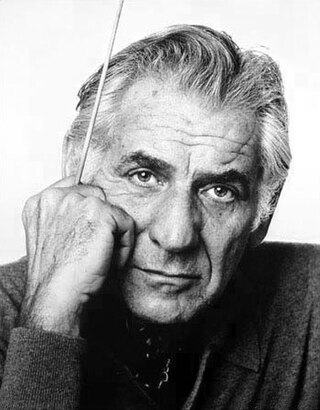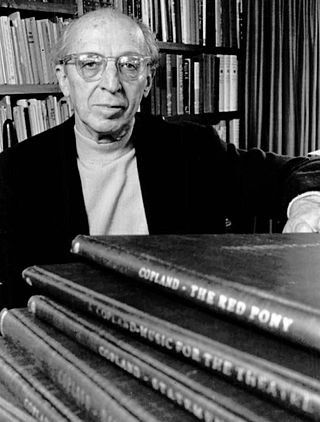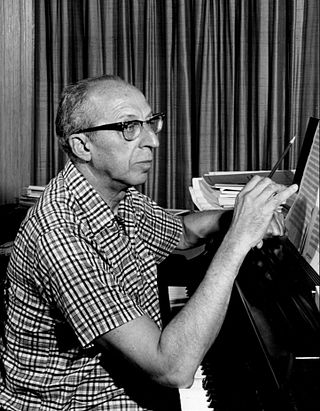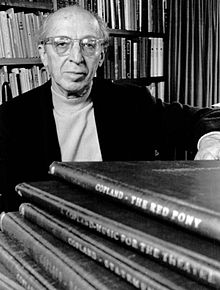
Leonard Bernstein was an American conductor, composer, pianist, music educator, author, and humanitarian. Considered to be one of the most important conductors of his time, he was the first American-born conductor to receive international acclaim. Bernstein was "one of the most prodigiously talented and successful musicians in American history" according to music critic Donal Henahan. Bernstein's honors and accolades include seven Emmy Awards, two Tony Awards, and 16 Grammy Awards as well as an Academy Award nomination. He received the Kennedy Center Honor in 1981.

Aaron Copland was an American composer, critic, writer, teacher, pianist and later a conductor of his own and other American music. Copland was referred to by his peers and critics as the "Dean of American Composers". The open, slowly changing harmonies in much of his music are typical of what many people consider to be the sound of American music, evoking the vast American landscape and pioneer spirit. He is best known for the works he wrote in the 1930s and 1940s in a deliberately accessible style often referred to as "populist" and which the composer labeled his "vernacular" style. Works in this vein include the ballets Appalachian Spring, Billy the Kid and Rodeo, his Fanfare for the Common Man and Third Symphony. In addition to his ballets and orchestral works, he produced music in many other genres, including chamber music, vocal works, opera and film scores.

Charles Edward Ives was an American modernist composer, actuary and businessman. Ives was among the earliest renowned American composers to achieve recognition on a global scale. His music was largely ignored during his early career, and many of his works went unperformed for many years. Later in life, the quality of his music was publicly recognized through the efforts of contemporaries like Henry Cowell and Lou Harrison, and he came to be regarded as an "American original". He was also among the first composers to engage in a systematic program of experimental music, with musical techniques including polytonality, polyrhythm, tone clusters, aleatory elements, and quarter tones. His experimentation foreshadowed many musical innovations that were later more widely adopted during the 20th century. Hence, he is often regarded as the leading American composer of art music of the 20th century.
EXPO is an orchestral composition by the Finnish composer Magnus Lindberg. It was the first work commissioned by the New York Philharmonic under the conductor Alan Gilbert, and was Lindberg's first commission as the orchestra's composer-in-residence. The piece was first performed on September 16, 2009 at Avery Fisher Hall, New York City, during Alan Gilbert's inaugural concert with the New York Philharmonic. EXPO was the first newly commissioned work to open the New York Philharmonic's concert season since the premiere of Aaron Copland's Connotations under Leonard Bernstein on September 23, 1962.
Harold Samuel Shapero was an American composer.

Serge Koussevitzky was a Russian and American conductor, composer, and double-bassist, known for his long tenure as music director of the Boston Symphony Orchestra from 1924 to 1949.

Walter Hamor Piston, Jr., was an American composer of classical music, music theorist, and professor of music at Harvard University.
David Walter Del Tredici was an American composer. He won a Pulitzer Prize for Music and was a Guggenheim and Woodrow Wilson fellow. Del Tredici is considered a pioneer of the Neo-Romantic movement. He was also described by the Los Angeles Times as "one of our most flamboyant outsider composers".

Appalachian Spring is an American ballet created by the choreographer Martha Graham and the composer Aaron Copland, later arranged as an orchestral work. Commissioned by Elizabeth Sprague Coolidge, Copland composed the ballet music for Graham; the original choreography was by Graham, with costumes by Edythe Gilfond and sets by Isamu Noguchi. The ballet was well received at the 1944 premiere, earning Copland the Pulitzer Prize for Music during its 1945 United States tour. The orchestral suite composed in 1945 was played that year by many symphony orchestras; the suite is among Copland's best-known works, and the ballet remains essential in the Martha Graham Dance Company repertoire.
Lincoln Portrait is a 1942 classical orchestral work written by the American composer Aaron Copland. The work involves a full orchestra, with particular emphasis on the brass section at climactic moments. The work is narrated with the reading of excerpts of Abraham Lincoln's great documents, including the Gettysburg Address. An orchestra usually invites a prominent person to be the narrator.
Aaron Copland's Clarinet Concerto was written between 1947 and 1949, although a first version was available in 1948. The concerto was later choreographed by Jerome Robbins for the ballet Pied Piper (1951).
The Piano Variations of American composer Aaron Copland were written for piano solo from January to October 1930. They were dedicated to American writer and literary critic Gerald Sykes, and were originally published in 1932 by Cos Cob Press, which merged with Arrow Music Press in 1938 and was taken over by Boosey & Hawkes in 1956. The approximate performance time is 11 minutes.
Harold Shapero completed the Symphony for Classical Orchestra in B-flat major on March 10, 1947, in Newton Centre, Massachusetts. It is written for an orchestra consisting of piccolo, 2 flutes, 2 oboes, 2 clarinets in B-flat, 2 bassoons, contrabassoon, 2 horns in F, 2 trumpets in C, 2 tenor trombones and one bass, timpani and strings. Although labelled "Classical," many of the work's features point to Beethoven rather than Haydn or Mozart, such as "the way in which Shapero paces himself, alternating long passages in the tonic and the dominant, with fast, dramatic modulations often reserved for transitions and developments." Nicolas Slonimsky remarked on how the piece is "premeditatedly cast in the proclamatory key of B-flat major, the natural tonality of the bugle, and ending in a display of tonic major triads." But there are modern features as well, with "the work's orchestration, in general, ... distinctively bright and brassy, and undoubtedly derived a fair amount from Piston and Copland, as well as from the composer's experience as a dance band arranger."
Quiet City is a composition for trumpet, cor anglais or oboe, and string orchestra by Aaron Copland. In the published score, the composer indicates "use Oboe only if no English Horn is available."
Aaron Copland wrote the Symphony for Organ and Orchestra in 1924. It represents a major work in the composer's oeuvre, as it was his first fully realized orchestral work, his first work for organ, and the first piece whose orchestration he heard. It was premiered on January 11, 1925, in New York. In 1928, Copland re-orchestrated the work without organ as his Symphony No. 1, rewriting the organ part in the brass and adding saxophone.

Inscape is a 1967 musical composition for orchestra by Aaron Copland, approximately twelve to thirteen minutes in length, and commissioned by and dedicated to the New York Philharmonic for its 125th anniversary. Composed using the twelve-tone technique, the piece has been considered less accessible than much of Copland's earlier music. It is named for Gerard Manley Hopkins's term "inscape", invented:
to suggest 'a quasi-mystical illumination, a sudden perception of that deeper pattern, order, and unity which gives meaning to external forms.' This description, it seems to me, applies more truly to the creation of music than to any of the other arts.
Dance Panels is a ballet composed by Aaron Copland in 1959 for a planned collaboration with choreographer Jerome Robbins. After Copland had written the score, Robbins reneged on his commitment and the performance did not take place. Three years later, Copland revised the score for a ballet by the Bavarian State Opera in Munich, Germany, where it premiered on 3 December 1963. The ballet was performed by the New York City Ballet in 1965 and the concert version received its first performance at the Ojai Music Festival the following year. According to Copland biographer Howard Pollack, Dance Panels has proven from a musical standpoint one of the composer's more accessible late scores. While some of its more dissonant moments sound similar to Copland's twelve-tone compositions, other parts recall his earlier stage and screen music. It is also the only one of Copland's six ballets not written to a specific program.

Danzón cubano is a composition for two pianos by American composer Aaron Copland. The piece, written in 1942, was inspired by the Cuban genre of the same name. It was first arranged for orchestra in 1946.
The Concerto for Piano and Orchestra is a musical composition by the American composer Aaron Copland. The work was commissioned by the conductor Serge Koussevitzky who was then music director of the Boston Symphony Orchestra. It was first performed on January 28, 1927, by the Boston Symphony Orchestra conducted by Koussevitzky with the composer himself as the soloist. The piece is dedicated to Copland's patron Alma Morgenthau Wertheim.
The Short Symphony, or Symphony No. 2, is a symphony written by the American composer Aaron Copland from 1931 to 1933. The name derives from the symphony's short length of only 15 minutes. The work is dedicated to Copland's friend, the Mexican composer and conductor Carlos Chávez. The symphony's first movement is in sonata-allegro form, and its slow second movement follows an adapted ternary form. The third movement resembles the sonata-allegro but has indications of cyclic form. The composition contains complex rhythms and polyharmonies, and it incorporates the composer's emerging interest in serialism as well as influences from Mexican music and German cinema. The symphony includes scoring for a heckelphone and a piano while omitting trombones and a percussion section. Copland later arranged the symphony as a sextet.










